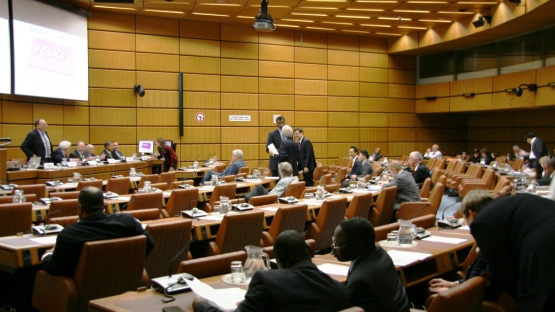On 22 September 2014, the International Nuclear Safety Group (INSAG) held its annual forum during the 58th General Conference of the IAEA. INSAG Chairman Richard Meserve and a panel of nuclear safety experts explored "Defence-in-Depth" and the way forward for further strengthening nuclear safety worldwide.
Defence-in-Depth is a nuclear safety concept relating to the designing and operating of nuclear facilities that aims to prevent and mitigate accidents. The key is creating multiple independent and redundant layers of defence. This means that the safety and security system in place should be able to compensate for potential human and mechanical failures so that no single layer, no matter how robust, is exclusively relied upon. Defence-in-depth includes the use of stringent access controls, physical barriers, redundant and diverse key safety functions, and effective emergency response measures.
Defence-in-Depth is a safety approach whose effectiveness must be periodically evaluated, tested, and improved upon should new concerns or challenges arise.
After initial introductions by Richard Meserve, Jacques Reyaldo of the World Association of Nuclear Operators (WANO) and Électricité de France (EDF), presented and explained WANO’s actions in regard to improving safety post- 2011 Fukushima nuclear accident. He spoke on WANO’s efforts to increase the frequency of power plant reviews, and use the results to grade its member’s plants and provide them with a set of best operating practices. The plants’ grades given by WANO are kept confidential, which led to some discussion during this event on transparency and keeping the public informed while maintaining the trust between WANO and its members.
Opening his presentation with words of caution, Mike Weightman, one of Britain’s top nuclear safety inspectors and member of INSAG, stated “The Fukushima accident didn’t ruin the civil nuclear industry, but another one could.” His presentation called for the nuclear industry to adapt to the expectations of the public today. He emphasized the need to develop ethics and values that would be stronger than laws and regulations and would help instil a safety culture in the nuclear industry.
The event’s final speaker was Aybars Gürpinar, an IAEA consultant, who raised the point that nuclear operators and authorities should prepare for external events – events that are not normally considered. He spoke of the "beyond design basis stress tests" conducted on nuclear power plants after the Fukushima accident, and highlighted that they did not consider situations of a non-seismic cause. He also highlighted the issue that there was not much regulatory guidance covering non-seismic external events and called for more work to be done towards preparing nuclear facilities for external events of a non-seismic nature.
INSAG will continue to give utmost priority to defence in-depth in its various aspects.
Background
INSAG is a group of experts, from 14 countries and organizations, with high professional competence in the field of nuclear safety working in regulatory organizations, research and academic institutions and the nuclear industry. It is convened under the auspices of the IAEA with the objective to provide authoritative advice and guidance on nuclear safety approaches, policies and principles.


